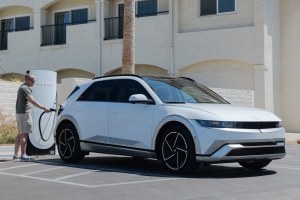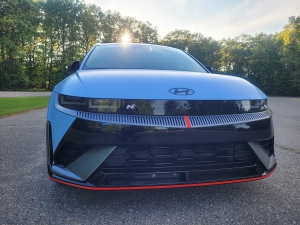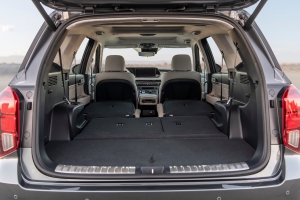Hyundai Ioniq 5: 5 Things to Know
While there are some people still skeptical of embracing the electric vehicle movement, there are plenty of folks who want to have one in their driveway, and a solid list of available EVs to help them achieve that goal.
Hyundai is among the companies that has embraced the electric movement, offering a strong lineup of EVs — including the excellent Ioniq 5 compact SUV, which I was recently able to spend some time with.
Read on to learn 5 things that you need to know about the Ioniq 5 to determine if it’s the right EV for you, as it battles other electric vehicles such as the Ford Mustang Mach-E, Volkswagen ID.4, Tesla Model Y, and Kia EV6.
1. Strong EV range, fast charging
Range on the Ioniq 5 will span from 245 miles (on base model) up to 318 miles (on RWD models in SE/SEL/Limited trims). AWD options land between 259 miles and 290 miles. The Ioniq 5’s numbers are competitive, as they are among the best you’ll find in this size of EV, limiting any range anxiety.
One reality check: Keep in mind that if you live in colder weather climates, cold temperatures can impact the actual distance and limit mileage of any EV you purchase.
Charging at home overnight with a Level 2 charger is the best option for any EV, but if you must charge publicly for any reason, the Ioniq 5 is compatible with the fast 350 kW public chargers that can get you from 10 percent to 80 percent in about 20 minutes, and is also compatible with Tesla superchargers.
2025 Hyundai Ioniq 5 N is a powerful, sporty electric SUV
While the regular version of the Hyundai Ioniq 5 is a solid offering, the brand was smart to realize that driving aficionados are always looking for that little bit extra, and the ultra-powerful 2025 Hyundai Ioniq 5 N was born.
New for the 2025 model year, this all-wheel-drive electric SUV from Hyundai has the numbers to challenge everything in its class, and some contenders in classes above, and is focused purely on performance.
I recently spent some time behind the wheel of an Ioniq 5 N — with its 641 horsepower and racecar-worthy setup — and I’m back with with a full report.
2025 Hyundai Kona is a small but fun compact SUV option
When it comes to SUVs, Hyundai is one brand with a stacked lineup that has all sizes covered — from those wanting a large three-row option all the way down to subcompact offerings.
One of the smaller and more affordable options from Hyundai (just one step up from the even smaller Hyundai Venue, but below the Hyundai Tucson) is the 2025 Hyundai Kona, a vehicle I recently had the chance to experience.
This funky looking but fun to drive commuter-friendly ride is among the better options for people looking for something on the smaller side, but isn’t underpowered. It received minor updates in 2025 after a fully updated version debuted in 2024.
There are plenty of rivals to consider — including the Chevy Trax and Mazda CX-30 to the Volkswagen Taos — but the Kona holds its own against them, especially on the performance end of things.
2025 Hyundai Ioniq 5 is a stylish, powerful electric SUV
While the much-anticipated transition to electric vehicles has its ups and downs in recent years at some car makes, other brands are ignoring all the drama and sticking to their plans or even accelerating their transition.
Once such brand is Hyundai, which offers several EV models including the Ioniq 5 — a compact electric SUV that I recently had the opportunity to experience.
The Ioniq 5 hits a nice sweet spot in the EV landscape, offering a smaller size, solid mileage range, a roomy interior and strong tech features.
New for 2025 is the XRT trim level, an off-road friendly model, as well as extended range numbers, plus updates to its charging capabilities and interior.
Read on to find out how this vehicle, which is made at Hyundai’s plant in Georgia, compares in the segment to rivals such as the Ford Mustang Mach-E and Volkswagen ID.4, Tesla Model Y, and Kia EV6.
2025 Hyundai Sonata hybrid offer sleek design, solid tech, roomy interior
Automakers are wisely leaning into their hybrid lineups as the switch to EVS happens at a slower pace than many had anticipated.
One brand with a strong hybrid lineup is Hyundai, including its midsize sedan offering — the Sonata hybrid, which competes mainly with hybrids from Toyota (Camry) and Honda (Accord).
I recently spent some time behind the wheel of a 2025 Hyundai Sonata Limited hybrid, and I’m back with a full report on how it holds up in this resurging category of vehicles.
2025 Hyundai Elantra hybrid delivers style, fuel efficiency
Hybrids are a major discussion right now in the auto industry as companies pull back on their plans to expand EV lineups.
Many people want fuel efficiency, but still want to be able to go to the gas station, at least until EV prices come down and EV infrastructure is improved.
To reach these people now, vehicles like the 2025 Hyundai Elantra hybrid are plugging the gap and earning increased interest. Offering strong fuel mileage, attractive design, and an affordability EVs can’t deliver yet, they are seeing increased interest.
I recently tested a 2025 Elantra hybrid, and I’m back with a full report on this sold hybrid sedan option — which competes with vehicles such as the Honda Civic hybrid, Toyota Corolla hybrid and Toyota Prius.
2025 Hyundai Tucson refresh adds tech, design upgrades
With the compact SUV being one of the most popular options for car buyers, it’s important for brands to keep their entries in this class relevant.
Hyundai has an impressive overall SUV lineup, and that includes the compact Tucson, which gets some refreshes for 2025 — including design updates as well as an improved tech setup.
It also comes in hybrid and plug-in hybrid versions, which can entice eco-friendly buyers, and remains an option for the budget-conscious buyer due to its pricing and strong warranties.
I recently spent some time behind the wheel of the 2025 Hyundai Tucson — which faces tough competition from the Toyota RAV4, Chevy Equinox, Honda CR-V, Ford Escape, Nissan Rogue, Mazda CX-50, Kia Sportage and more.
Read on for a full breakdown of how it holds up in the segment.
2024 Hyundai Palisade is a high-end, high-tech three-row SUV
Relatively young in its life span, having been introduced in 2020, the Hyundai Palisade is a vehicle that has quickly gained a strong reputation in the highly competitive midsize SUV competition.
Alongside its corporate relative the Kia Telluride (a very similar vehicle in many ways), this three-row SUV offering is a family-friendly gem and one of the best new options to come along in recent years, and it continues to shine in 2024.
I recently spent some time behind the wheel of a a 2024 Palisade Calligraphy — which delivers an upscale design, comfort, and strong tech — and I’m back with a full report on how it’s holding up against a growing number of SUV competitors in this segment (such as the new Mazda CX-90 and Toyota Grand Highlander).
Bold, attractive 2024 Hyundai Tucson is a compact SUV standout
In recent years, Hyundai has asserted itself as a strong contender in many different vehicle categories, and that’s probably the most true in the compact SUV segment, where its Hyundai Tucson has regularly been a top-seller.
It’s the most popular Hyundai model in the U.S., with over 200,000 Tucsons sold in 2023, in large part due to its standout exterior design, roomy and upscale interior, plus comprehensive warranties and competitive pricing.
I recently tested a 2024 Hyundai Tucson XRT AWD model, which featured an attractive and aggressive design, and there are a variety of Tucson models offered — including hybrid options for the eco-friendly buyer.
Last fully redesigned in 2022, the 2024 Tucson features minor changes to the various trim levels and adds some tech and safety features, but maintains the strong features that have kept it so competitive in a segment featuring strong competition including the Honda CR-V, Nissan Rogue, Ford Escape and Toyota RAV4.
Hyundai Ioniq 6 offers impressive range and power; capable of taking the fight to Tesla
It’s an interesting time for the world of electric vehicles.
Story after story talks about how the EV revolution is falling short and demand isn’t living up to expectations.
But don’t tell that to Hyundai, who are rising to become perhaps the biggest star in the EV field behind Tesla, which had a bit of a head start on the legacy automakers.
The Ioniq 6 is one of Hyundai’s stronger EV offerings, and is the sedan version of their Ioniq 5 crossover. Its most direct competitor is the Tesla Model 3, but it is also high-end enough to take on upscale vehicles like the BMW i4 and the Polestar 2.
I recently spent some time behind the wheel of an Ioniq 6, and I’m back with a full report on how it measures up in today’s EV landscape.
News Categories
Popular Tags
Search Reviews by Make

AutoTechReviews is your home for In-depth reviews of the latest cars, trucks, and SUVs; information on all the emerging vehicle technology; and breaking news from the world of NASCAR and other motorsports.










